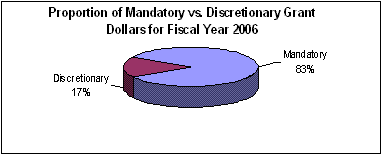Other Management Information and InitiativesGrants Management Our main line of business is the provision of assistance funds to be used for the improvement of health and human services for the citizens of this Nation and other nations around the world. Increasingly, successful attainment of our mission is linked to global issues and communities. We continue to be the largest assistance awarding agency in the Federal Government. Added to this distinction is the fact that our partners may be the widest spectrum of Federal assistance recipient types, including millions of individuals; American Indian, Alaska Native, and Native American governments; State governments and various sub- agencies; local governments and various sub-agencies; major research and training universities and colleges; a vast array of highly performing nonprofit organizations; and a growing number of research and service- oriented hospitals. We utilize payments, grant instruments of varying complexity, and a corresponding range of cooperative agreements to provide needed funding to recipients Over the last year, we have significantly enhanced our Office of Grants policy and system modernization capabilities in order to provide a firm foundation for future growth and expansion of our main line of business. Supporting these efforts are several major system modernization efforts, including the maintenance and improvement of the Tracking Accountability in Government Grants System, a comprehensive Department-wide data base with full search capabilities for all awards, including grants, cooperative agreements, and contracts. This data base also provides access to current policies, regulations, and other pertinent grants-related information at www.taggs.hhs.gov. We continue to serve as the managing partner for www.grants.gov, which is a unified, citizen-centric website designed to make information accessible in a single location to simplify the grants application process.  The coupling of grants policy with system modernization may best exemplified in the new Forecast of HHS Grant Opportunities tool now under development by the Office of Grants. This will be released for public use during fall 2007 to enable all applicants to identify upcoming assistance funding opportunities well in advance of their posting to www.Grants.gov , which is the Federal Government’scentral storehouse for information on over 1,000 grant programs and access to approximately $400 billion in annual awards. We are committed to providing applicants with the maximum time available to prepare for making application for its awards. Although some forecasted programs may not be funded, at least applicants can identify a group of potential interest and be prepared to pursue those as they are posted for formal application. The coupling of grants policy with system modernization may best exemplified in the new Forecast of HHS Grant Opportunities tool now under development by the Office of Grants. This will be released for public use during fall 2007 to enable all applicants to identify upcoming assistance funding opportunities well in advance of their posting to www.Grants.gov , which is the Federal Government’scentral storehouse for information on over 1,000 grant programs and access to approximately $400 billion in annual awards. We are committed to providing applicants with the maximum time available to prepare for making application for its awards. Although some forecasted programs may not be funded, at least applicants can identify a group of potential interest and be prepared to pursue those as they are posted for formal application.
 We manage an assortment of grant programs in basic and applied science, public health, income support, child development, and health and social services. Through these programs, we awarded nearly 75,600 grants totaling more than $228 billion in FY 2006. These programs are our primary means to achieving our strategic goals. We manage an assortment of grant programs in basic and applied science, public health, income support, child development, and health and social services. Through these programs, we awarded nearly 75,600 grants totaling more than $228 billion in FY 2006. These programs are our primary means to achieving our strategic goals.
We manage two types of grants: mandatory and discretionary. Mandatory programs are those that a Federal agency is required by statute to award if the eligible recipient submits an application that meets the program requirements. Discretionary grants permit the Federal Government, according to specific legislation, to exercise judgment in selecting the project or proposal to be supported and selecting the recipient organization. The Federal agency may use discretionary funds for both unsolicited proposals and those announced opportunities that require a competitive process. As is the case with prior years, most of our grants awards were discretionary (94 percent of total grant volume awarded), yet most dollars associated with Departmental grants were mandatory (83 percent of total dollars awarded). The National Institutes of Health awards the majority (71 percent) of our total discretionary awards, but only 9 percent of total grant dollars, indicating a low dollar per grant ratio. The Administration for Children and Families awards the greatest number of mandatory awards, while the Centers for Medicare & Medicaid Services award the majority of mandatory dollars (64 percent) through a small number of awards, indicating a high dollar per grant ratio. The percentages of our component total grant dollars and volume essentially have remained the same since FY 2001.  
Date of Report: November 15, 2007
AFR Section I Links:- Other Management Information and Initiatives
|